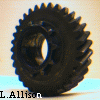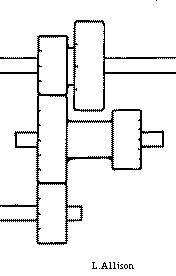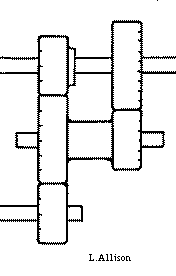 - hi output cog (S2A), this one is u/s!
- hi output cog (S2A), this one is u/s!
 - hi output cog (S2A), this one is u/s!
- hi output cog (S2A), this one is u/s!
Drive is taken from the gearbox output shaft, via an idler gear, to the rear transfer-case output shaft. A dog-clutch locks the front output shaft to the rear output shaft to engage drive to the front wheels (ie. 4WD). The lo-ratio output cog carries a dog-clutch and is splined to the output shaft. In hi-ratio, the lo-ratio cog merely locks the hi-ratio cog to the output shaft. In lo-ratio, the lo-ratio cog takes the drive directly to the output shaft. The lo-ratio output cog is straight-cut (except on 1-ton transfer cases?) and is normally quite noisy when selected.
 hi-ratio,
hi-ratio,
 lo-ratio (not to scale!).
lo-ratio (not to scale!).
The diff-lock is open to abuse: If it is engaged on good roads it will cause transmission wear. If it not engaged early enough on loose surfaces it may allow the centre diff (which is small and rotates 3.5 times more rapidly than the road wheels) to overheat and eventually fail. Maybe this is why later RRs uses the viscous coupling? The system is strong and durable if used correctly.
It is most important that the front and rear output shafts of these transfer cases do not run at radically different speeds for long periods. For example, dynamometer tests must either be done with all four wheels rotating at the same speed or, failing that, the propshaft to the stationary axle must be disconnected and the centre diff lock engaged. Similarly in suspended towing, the propshaft to the rotating axle must be disconnected.
Most of these transfer cases use the standard arrangement of input shaft (from the gearbox), intermediate shaft and output shafts, the latter embodying the centre differential. Later RRs (about 1992 on) instead use a `silent chain' or `Morse chain' to carry the drive from the input shaft directly to the output shaft. A viscous coupling replaces the centre diff' lock. The hi/lo range selection is done by epicyclic gears in the end of the gearbox output-shaft / transfer case input shaft, where a PTO would normally fit.